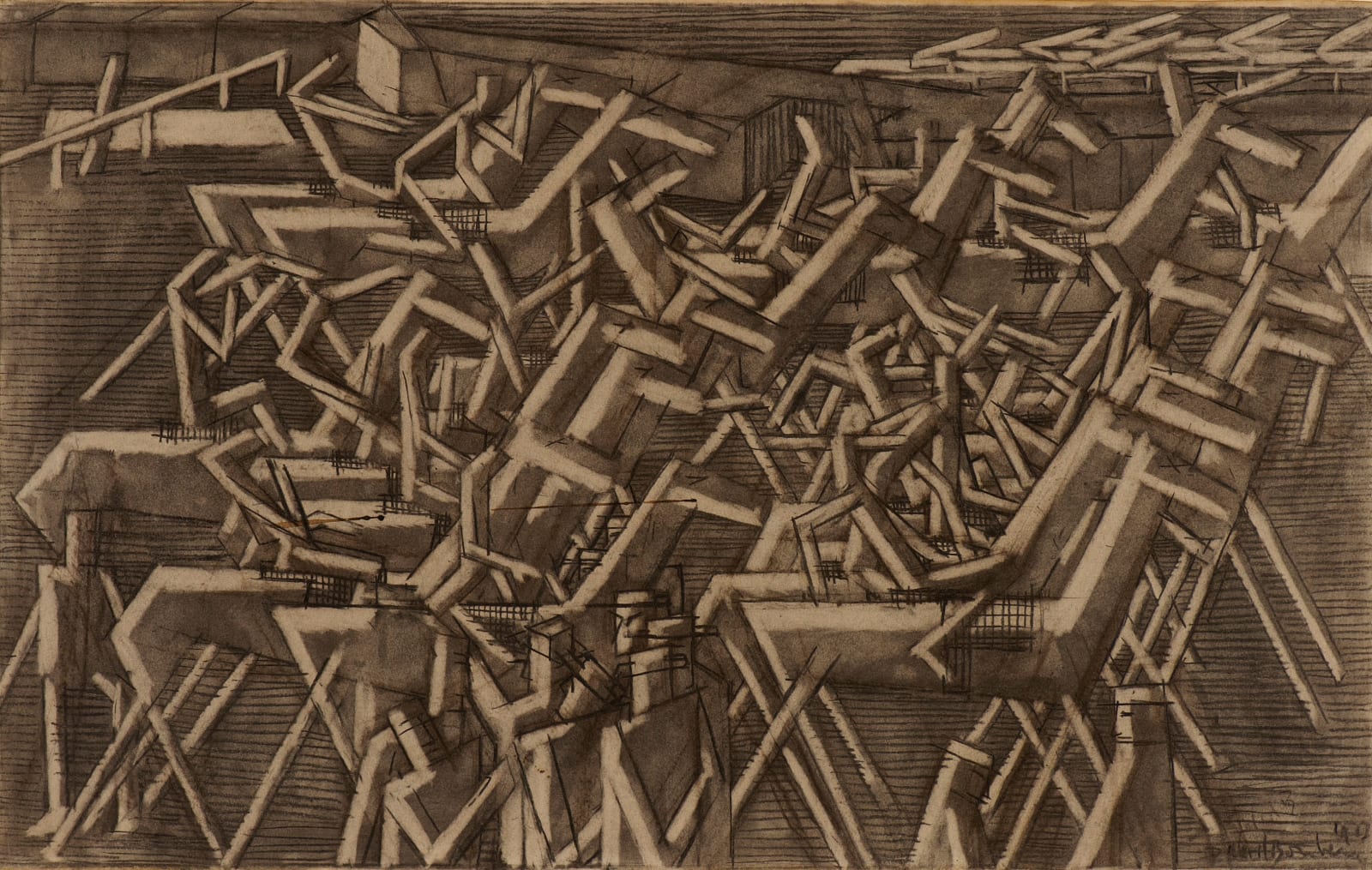David Bomberg 1890-1957
framed: 73 x 97 cm
This radical chalk-and-wash drawing was among Bomberg's five exhibits in the so-called ‘Jewish Section’ that he co-curated with Jacob Epstein at the Whitechapel Art Gallery’s exhibition 'Twentieth Century Art: A Review of Modern Movements' in May 1914 (he had previously shown it at the Friday Club in February and included it again in his solo show at the Chenil Gallery in July). Bomberg's friend John Rodker (a racing enthusiast) also reproduced the drawing as a frontispiece in The Dial Monthly, explaining that it was set in a paddock at a race meeting, that the two figures on the front right of the composition were bookies, those to their left spectators, and that the style was ‘cubist’; adding ‘It is not intended to be comic’. Executed in 1913, when Bomberg was only 22, Racehorses is a key transitional work, which demonstrates his absorption and understanding of the contemporaneous European avant-garde, skilfully reworked into a drawing of startling power and originality.
Even before he became a student at the Slade School of Fine Art, Bomberg had begun to employ a shallow picture space and to simplify his forms. By 1913 he was producing ‘Cubist compositions’ including one featuring the wooden ‘donkey’ on which students sat to sketch in the Slade life class (which bears a close resemblance to Bomberg’s stiffly-jointed racehorses). His understanding of Cubism was enhanced by his visit to Paris in 1913 and he was also aware of the 1910 Futurist Manifesto with its explanation that ‘a running horse has not four legs, but twenty, and their movements are triangular’. He shared a fascination with mechanisation with the nascent Vorticist movement, reflected in his manifesto accompanying his first solo show at the Chenil gallery, London, in July 1914, where he explained that his object was ‘the construction of Pure Form’. However Bomberg also combined modernist techniques with allusions to older processes: the close-grained texture of the picture is reminiscent of woodcuts, and the monochrome colouring akin to that in photography of the day. He would have been familiar with Eadweard Muybridge’s famous photographs of the ‘animal in motion’, and his racehorses also neatly illustrate what Muybridge himself noted in his ‘Prelude to Analyses’, that ‘during very rapid motion by a good horse, the aggregate of the body preserves a nearly horizontal line'. Like Bomberg’s other innovative works, Racehorses was generally viewed with hostility and incomprehension when first exhibited with the Jewish Chronicle calling his racehorses ‘Opposed to all that is rational in art’.
Provenance
Acquired at Sotheby's in 2004; Ben Uri was generously represented in this acquisition by James Holland-Hibbert of Hazlitt Holland-Hibbert with the assistance of Art Fund, the HLF and the MLA/ V&A Purchase Grant Fund, The Julius Silman Charitable Trust, Pauline and Daniel Auerbach, Sir Michael and Lady Heller and anonymous donorsExhibitions
1914 Jewish Section, Twentieth Century Art: A Review of Modern Movements, Whitechapel Art Gallery
1914 Pictures by Members of the Friday Club, Alpine Club Gallery
1914 Works by David Bomberg, Chenil Gallery
2006 Recent Acquisitions 2001-2006, Ben Uri Gallery - The London Jewish Museum of Art
2007 Bomberg's Relevance, Ben Uri Gallery - The London Jewish Museum of Art
2009 Homeless & Hidden 1: World Class Collection Homeless & Hidden, Ben Uri Gallery
2009 Whitechapel Boys, Whitechapel Art Gallery
2009 Sir Muirhead Bone: Artist & Patron, The Fleming Collection
2010 Apocalypse: unveiling a lost masterpiece by Marc Chagall and 50 selected masterworks from the Ben Uri Collection, Osborne Samuel
2013 Nash, Nevinson, Spencer, Gertler, Carrington, Bomberg: A Crisis of Brilliance, 1908-1922, Dulwich Picture Gallery
2013 Selected Highlights from over 200 works acquired during 2003-2013, Ben Uri Art Gallery
2015 Out of Chaos – Ben Uri: 100 Years in London, Somerset House
2016 100 for 100: Ben Uri Past, Present & Future, Christie's South Kensington
2016 Out of Chaos: Touring exhibition, Laing Art Gallery
2018 Bomberg, Ben Uri Gallery and Museum
2017 Bomberg: Touring Exhibition, Pallant House Gallery
2018 Acquisitions and Long-Term Loan Highlights Since 2001, Ben Uri Gallery
2018 Bomberg: Touring Exhibition, Laing Art Gallery
2019 Mark Gertler: Paintings from the Luke Gertler Bequest & Selected Important UK Collections, Ben Uri Gallery
2023 Art, Identity, Migration - Ben Uri at the London Art Fair, Business Design Centre
2023 Futurliberty, Museo del Novecento
Literature
Sarah MacDougall and Rachel Dickson, Bomberg (London: Ben Uri Gallery and Museum, 2017);
Rachel Dickson and Sarah MacDougall, eds., Out of Chaos: Ben Uri; 100 Years in London' (London: Ben Uri Gallery, 2015), pp. 40-41;
Selected Highlights from over 200 works acquired during 2003-2013 (London, Ben Uri Gallery, 2013), illus;
Sarah MacDougall, ‘Something is Happening There’: The Whitechapel Boys, 1914 and the Great War', in ed., Michael J K Walsh, London, Modernism, and 1914 (Cambridge: Cambridge University Press, 2010), pp. 122-147;
David Glasser, intro., 'Recent Acquisitions 2001-2006' (London: Ben Uri Gallery, 2006) p. 7, illus;
Andrew Graham-Dixon, In the Picture, The Sunday Telegraph Magazine, 13 March 2005;
Sarah MacDougall, David Bomberg's Racehorses (Ben Uri Gallery, 2005);
Richard Cork, David Bomberg (New Haven and London: Yale University Press, 1987), pp. 46, 96;
John Rodker, 'The New Movement in Art', The Dial Monthly, May 1914, pp. 184-8;
L. K., 'Jewish Art at Whitechapel', Jewish Chronicle, 15 May 1914, p. 10.



